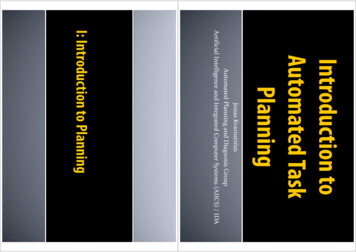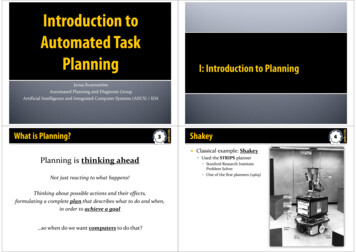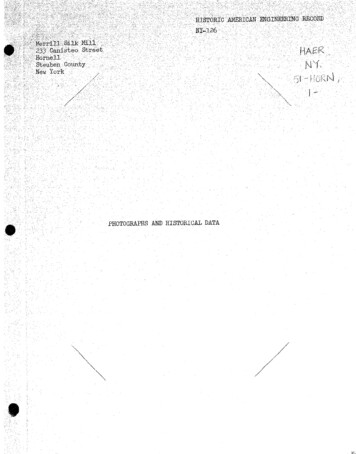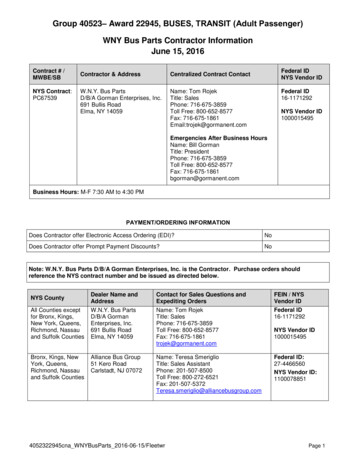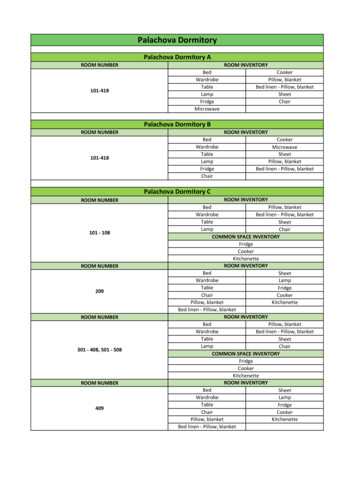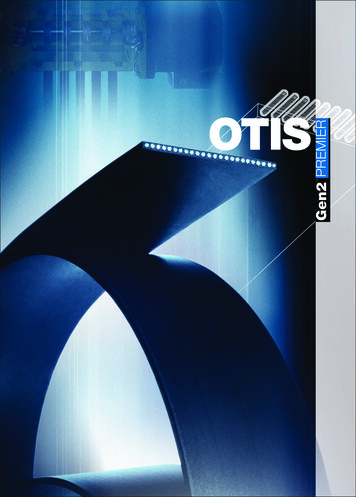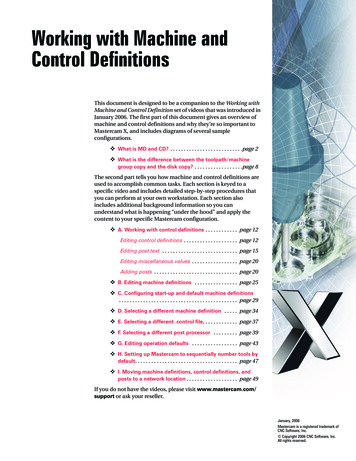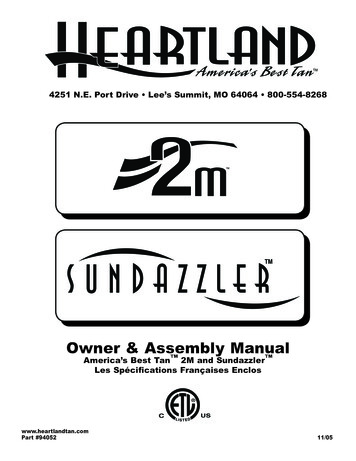
Transcription
PASSENGER ELEVATORS(MACHINE-ROOM-LESS SYSTEM)Series-IP Version21800kg, 2025kg, 2250kg, 2500kg
Utilizing its technological prowess and extensive experience, we have remaineda leader in the vertical transportation market since entering the business in 1931.The Company’s creative, innovative spirit, represented by production of theworld’s first spiral escalator and elevator group-control systems that use artificialintelligence technologies, continues to receive high evaluations industry-wide.Our products and systems are renowned for their high levels of quality, reliabilityand safety; and it is this sense of security and trust fostered with building ownersand end-users alike that has led to the global expansion of our elevator/escalatorbusiness and the after-sales network to service it.We understand responsibilities as a good corporate citizen, and continue to implement measures for protecting the environment and ensuring a sustainable societyfor future generations. A number of original technologies are being introduced toensure more efficient products, systems and manufacturing operations, therebyenhancing productivity, reducing energy consumption and providing smoother,faster and more comfortable vertical transportation systems.12
PrincipleContentsBased on our policy, “Quality in Motion”,Green Technology5–6Machine-room-less7–8we provide elevators and escalators that willsatisfy our customers with high levels ofcomfort, efficiency, ecology and safety.Group Control9–10Standard Design11–12Features13–16Basic Specifications and Important Information on Elevator Planning17–18Application(m/sec)1.75Our elevators, escalators and building management systems are always evolving,helping achieve our goal of being the No.1 brand in quality.In order to satisfy customers in all aspects of comfort, efficiency and safety whilerealizing a sustainable society, quality must be of the highest level in all productsand business activities, while priority is place on consideration for the environment.As the times change, we promise to utilize the collective strengths of its advancedand environmental technologies to offer its customers safe and reliable productswhile contributing to society.1.6(Series-IP Version2)1.01800202522502500(kg)We strive to be green in all ofour business activities.We take every action to reduce environmentalburden during each process of our elevators’and escalators’ lifecycle.* Quality in Motion is a trademark of Mitsubishi Electric Corporation.34
Using Energy WiselyOur long-term commitment to developing energy-efficient elevators has created systems and functionsthat make intelligent use of power.Milestones of Energy-saving Technologies in Elevator Development1970Green Technology201020 0 0Permanent magneI n d u c t i o n m o to rMotorAC2 controlControl circuitPower consumption /CO2 emissions *3AC V V *1 controlV V VF*2 controlRelay100%t m oto rG e ar l essWorm gearedTraction machineMotor drive19901980M i c r o co m p u t e r93%74%37%30 %Notes:*1: Alternative current, variable voltage*2: Variable voltage, variable frequency*3: CO2 emissions in this table are from elevatoroperation and do not include emissions frommanufacturing, transportation and other processes.Approx.–70%SUSTAINABLE ENERGY USEOur leading-edge technologies have made it possible for elevators to conserve energy. Our regenerative convertermakes the most of power generated by the traction machine. Additionally, thanks to the joint-lapped core inpermanent magnet (PM) motor and energy-saving features, the elevators use energy more wisely and efficiently.Joint-lapped Core in PermanentMagnet (PM) MotorRegenerative Converter : PCNV (Optional)Efficient use of powerElevators usually travel using power from a power supply(powered operation); however, when they travel down witha heavy car load or up with a light car load (regenerativeoperation), the traction machine functions as a powergenerator. Although the power generated during tractionmachine operation is usually dissipated as heat, theregenerative converter transmits the power back to thedistribution transformer and feeds it into the electricalnetwork in the building along with electricity from thepower supply. Compared to the same type of elevatorwithout a regenerative converter, this system provides anenergy-saving effect of approximately 35%.* In addition,the regenerative converter has the effect of decreasingharmonic currents.Note:* The value is a reference datum and may increase or decrease in accordancewith actual conditions of use and elevator specifications.MotorMotorControl panel ®enerativeconverterControl panel ®enerativeconverterEnergy-saving FeaturesSmaller carbon footprintCurbing energy consumptionThe joint-lapped core built into the PM motor of thetraction machine features flexible joints. The iron coreacts like a hinge, which allows coils to be wound aroundthe core more densely, resulting in improvedmotor efficiency and compactness. A high-densitymagnetic field is produced, enabling lower use ofenergy and resources and reduced CO2 emissions.We offer features that help to reduce the energyconsumption of elevators.Energy-saving Operation– Number of Cars : ESO-N (Optional for ΣAI-22)The number of service cars is automatically reduced tosome extent without affecting passenger waiting time. Energy-saving Operation– Allocation Control : ESO-W (ΣAI-2200C only)Based on each elevator’s potential energy consumption,the system selects the elevator that best balancesoperational efficiency and energy consumption.Car Light/Fan Shut Off– Automatic : CFO-A/CLO-AThe car lighting/ventilation fan is automatically turnedoff if there are no calls for a specified period.Distribution transformerPower supplyPowered operation5Distribution transformerPower supplyRegenerative operation6
Machine-room-lessSPACE-SAVINGAs all equipment is installed within thehoistway, there are fewer restrictionson building design except for the actualspace required for the shaft. Architectsand interior designers have more designfreedom.Compact PM Gearless Traction MachineCompact PM gearless machineSlim control panel7The gearless traction machine with a PM (permanentmagnet) motor is packed with cutting-edge technology,such as our unique stator-core structure and built-indouble brakes. This optimized motor design dramaticallyreduces the level of torque ripple, which positively affectsthe quality of the ride. So even though the machinery iscompact, the ride is smooth, quiet and comfortable.Furthermore, the PM motor suppresses harmonic noiseand torque ripple, providing greater riding comfort.Slim Control PanelMore technological advances, such as thehigh-accumulation LSI (large scale integration) and lownoise PWM (pulse wide modulation) inverter, enable theVVVF (variable voltage, variable frequency) inverter todeliver smooth, high-precision control of the tractionmachine.In addition, an IPU (integrated power unit) acts as ahigh-efficiency power supply circuit for the motor driveand, along with the PM motor, delivers greatenergy-savings. The result is more efficient, more reliabledrive control.8
Group ControlEFFICIENT TRANSPORTATIONOur breakthrough AI Neural Network* technology in elevator control enhances transport efficiency andreduces passenger waiting time through optimum car allocation, which allows elevators to use energyeffectively. Two basic group control systems offer a variety of innovative group control features.Note: *Neural Network is a mathematical model that emulates the structure of the nerves and cells of the human brain and its information processing mechanism.Group controlsystemsSuitable building sizeΣAI-22 systemSmall to mediumΣAI-2200C systemLarge(Especially, a buildingwith dynamic trafficconditions)PerformanceNumber of carsin a group3 to 4(sec)(sec)30 time25 25Based on real traffic data, passenger traffic is predicted every few minutes. According to the prediction, real-time simulationselects the best rule-set (multiple rules have been set as car allocation patterns), which optimizes transport efficiency.6 64 42 25 5The features introduced on these pages are applicable to ΣAI-2200C only.Please refer to pages 15 and 16, and the ΣAI-2200C brochure for otherfeatures and details.Selecting optimum car allocation through rule-set simulations15 1510 100 0MorningMorningpeakup uppeakDaytime LunchtimeLunchtime Max.40%40%Improved:0 0MorningMorningpeakup uppeakDaytime npeakWhen a hall call is registered, the algorithmpredicts near-future calls that could require longwaits. Through evaluation of the registered hallcall and the forecasted call, the best car is assigned.All cars work cooperatively for optimum operation.Allocates passengers to cars depending on destination No.No.When a passenger enters a destination floor at a hall, the hall operating panel immediately indicates which car will serve thefloor. Because the destination floor is already registered, the passenger does not need to press a button in the car. Furthermore, dispersing passengers by destination prevents congestion in cars and minimizes waiting and traveling time.Standard arrangement of hall fixtures (No hall lantern* is provided.)Cars receive destination information from all floors to provide the best service for more complex traffic conditions throughout the day.Example of hall arrangementAI-2100NAI-2100Nis registeredat 6th[A [Ahallhallcallcallis registeredat arcarB. B.[Anotheris soonregisteredat 11th[Anotherhallhallcallcallis soonregisteredat 11thFl.]Fl.]Allocatesresultingin longwaitof 26AllocatesD, D,resultingin longwaitof 26sec.sec.9Destination Oriented Allocation System : DOAS ive Optimization AssignmentForecasts a near-future hall call to reduce long waitsDynamic Rule-set Optimizer(%)(%)10 108 820 203 to I-2200C(latest)ΣAI-2200C(latest)[A hallis registeredat 6th[A hallcallcallis registeredat 6thFl.]Fl.]AllocatesD, whichis movingupward.AllocatesD, whichis movingupward.[Anotheris soonregisteredat 11th[Anotherhallhallcallcallis soonregisteredat 11thFl.]Fl.]AllocatesB, whichimmediatelyarrivesat thefloor.AllocatesB, whichimmediatelyarrivesat thefloor.Note:* Hall lanterns are available as optional.10
Standard DesignCarCar operating panelCeiling: S00HallHall position indicators and buttonsNarrow Jamb: E-102For front return panelWith plastic caseYellow-orange lightingTactile buttonPIV1-A1010N BoxlessCar Design ExampleWallsTransom panelDoorsFront return panelsKickplateFlooringCar operating panelSUS-HLSUS-HLSUS-HLSUS-HLAluminumPR803: GrayCBV1-C760CBV1-C760*1Segment LED indicators*2Tactile buttons with yellow-orange lightingJambDoorsHall position indicatorand buttonSegment LED indicators*2Tactile buttons with yellow-orange lightingSUS-HLSUS-HLPIV1-A1010NBoxlessCeiling : Painted steel sheet (Y033)with a milky white resin lighting coverLighting : Central lightingNotes:*1: Maximum number of floors: 22 floors *2: Some letters of the alphabet are not available. Please consult our local agents for details.11Hall Design ExamplePIV1-A1020N BoxlessActual colors may differ slightly from those shown.Please refer to the design guide for details and other designs.12
Features (1/2)FeatureDescriptionAbbreviation1C to 2C 3C to 4C 3C to 8C2BCΣAI-22 ΣAI-2200CFeaturen EMERGENCY OPERATIONS AND FEATURESn OPERATIONAL AND SERVICE FEATURESBuilding ManagementSystem —GateWayAttendant ServiceASAutomatic BypassABPA fully-loaded car bypasses hall calls in order to maintain maximum operational efficiency.Automatic Hall CallRegistrationFSATIf one car cannot carry all waiting passengers because it is full, another car will automatically beassigned for the remaining passengers.Backup Operation forGroup ControlMicroprocessorGCBKAn operation by car controllers which automatically maintains elevator operation in the eventthat a microprocessor or transmission line in the group controller has failed.Earthquake EmergencyReturnEmergency Car LightingFire Emergency ReturnFirefighters’ EmergencyOperationBMS-GWEER-PEER-SEach elevator’s status and operation can be monitored and controlled using a buildingmanagement system which manages various facilities in the building via the interface for theelevator system.Upon activation of primary and/or secondary wave seismic sensors, all cars stop at the nearestfloor, and park there with the doors open to facilitate the safe evacuation of passengers.ECLCar lighting which turns on immediately when power fails, providing a minimum level of lightingwithin the car. (Choice of dry-cell battery or trickle-charge battery.)FERUpon activation of a key switch or a building‘s fire alarm, all calls are canceled, all cars immediatelyreturn to a specified evacuation floor and the doors open to facilitate the safe evacuation ofpassengers.FEDuring a fire, when the fire operation switch is activated, the car calls of a specified car and allhall calls are canceled and the car immediately returns to a predetermined floor. The car thenresponds only to car calls which facilitate fire-fighting and rescue operation.MelEyeMitsubishi Elevators &Escalators Monitoring andControl SystemWP-WEach elevator’s status and operation can be monitored and controlled using an advanced Webbased technology which provides an interface through personal computers. Special optionalfeatures such as preparation of traffic statistics and analysis are also available.Mitsubishi EmergencyLanding DeviceMELDUpon power failure, a car equipped with this function automatically moves and stops at thenearest floor using a rechargeable battery, and the doors open to facilitate the safe evacuation ofpassengers. (Maximum allowable floor-to-floor distance is 10 meters.)OEPSUpon power failure, predetermined car(s) uses the building’s emergency power supply to moveto a specified floor, where the doors then open to facilitate the safe evacuation of passengers.After all cars have arrived, the predetermined car(s) resume normal operation.WPEach elevator’s status and operation can be remotely monitored and controlled through a panelinstalled in a building’s supervisory room, etc.Operation by EmergencyPower Source —Automatic/ManualSupervisory Paneln DOOR OPERATION FEATURES#1CCCCar Fan Shut Off —AutomaticCFO-AIf there are no calls for a specified period, the car ventilation fan will automatically turn off toconserve energy.Car Light Shut Off —AutomaticCLO-AIf there are no calls for a specified period,the car lighting will automatically turn off to conserveenergy.Continuity of ServiceCOSA car which is experiencing trouble is automatically withdrawn from group control operation tomaintain overall group performance.Elevator and SecuritySystem InterfaceEL-SCAEL-SCPersonal authentication by building’s security devices can trigger predetermined elevatoroperation such as permission of access to private floors, automatic registration of a hall call and adestination floor, and priority service.False Call Canceling —AutomaticFCC-AIf the number of registered car calls does not correspond to the car load, all calls are canceled toavoid unnecessary stops.False Call Canceling —Car Button TypeFCC-PIf a wrong car button is pressed, it can be canceled by quickly pressing the same button againtwice.The time doors are open will automatically be adjusted depending on whether the stop wascalled from the hall or the car, to allow smooth boarding of passengers or loading of baggage.Independent ServiceINDExclusive operation where a car is withdrawn from group control operation for independent use,such as maintenance or repair, and responds only to car calls.Automatic Door SpeedControlDSACDoor load on each floor, which can depend on the type of hall doors, is monitored to adjust thedoor speed, thereby making the door speed consistent throughout all floors.Next LandingNXLIf the elevator doors do not open fully at a destination floor, the doors close, and the carautomatically moves to the next or nearest floor where the doors open.Door Load DetectorDLDWhen excessive door load has been detected while opening or closing, the doors immediatelyreverse.Door Nudging Feature —With BuzzerNDGA buzzer sounds and the doors slowly close when they have remained open for longer than thepreset period. With the AAN-B or AAN-G feature, a beep and voice guidance sound instead of thebuzzer.Electronic DoormanEDMExtended Door-openButtonDKO-TBHall Motion SensorHMSMulti-beam Door Sensor Reopen with Hall ButtonROHBFailure of non-contact door sensors is checked automatically, and if a problem is diagnosed, thedoor-close timing is delayed and the closing speed is reduced to maintain elevator service andensure passenger safety.Door open time is minimized using the SR or Multi-beam Door Sensor feature that detectspassengers boarding or exiting.When the button inside a car is pressed, the doors will remain open longer to allow loading andunloading of baggage, a stretcher, etc.To enhance security, service to specific floors can be disabled using the car operating panel. Thisfunction is automatically deactivated during emergency operation.Non-service to SpecificFloors —Switch/Timer TypeNSNS-TTo enhance security, service to specific floors can be disabled using a manual or timer switch. Thisfunction is automatically deactivated during emergency operation.Non-service TemporaryRelease for Car Call —Card Reader TypeNSCR-COut-of-service by Hall KeySwitchHOSHOS-TFor maintenance or energy-saving measures, a car can be taken out of service temporarily with akey switch (with or without a timer) mounted in a specified hall.Multiple infrared-light beams cover some height of the doors to detect passengers orobjects as the doors close. (Cannot be combined with the SR feature.)Overload Holding StopOLHA buzzer sounds to alert the passengers that the car is overloaded. The doors remain open andthe car will not leave that floor until enough passengers exit the car.Closing doors can be reopened by pressing the hall button corresponding to the travelingdirection of the car.Regenerative ConverterPCNVReturn OperationRETUsing a key switch on the supervisory panel, a car can be withdrawn from group control operationand called to a specified floor. The car will park on that floor with the doors open, and not acceptany calls until independent operations begin.Safe LandingSFLIf a car has stopped between floors due to some equipment malfunction, the controller checksthe cause, and if it is considered safe to move the car, the car will move to the nearest floor at alow speed and the doors will open.Should an obstacle prevent the doors from closing, the doors will repeatedly open and close untilthe obstacle is cleared from the doorway.Safety Door EdgeSDEThe sensitive door edge detects passengers or objects during door closing.One or two infrared-light beams cover the full width of the doors as they close to detectpassengers or objects. (Cannot be combined with the Multi-beam Door Sensor feature.)Secret Call ServiceSCS-B#3To enhance security, car calls for desired floors can be registered only by placing a card overa card reader. This function is automatically deactivated during emergency operations.With a key switch on the supervisory panel, etc., a car can be called to a specified floor afterresponding to all car calls, and then automatically be taken out of service.RDCSRNS-CBRCSRepeated Door-closeSafety RayNon-service to SpecificFloors —Car Button TypeOut-of-service-remoteInfrared-light is used to scan a 3D area near the open doors to detect passengers or objects.#2When a car has responded to the final car call in one direction, the system regards remaining callsin the other direction as mistakes and clears them from the memory.Car Call CancelingDOTDODA1C to 2C 3C to 4C 3C to 8C2BCΣAI-22 ΣAI-2200CExclusive operation where an elevator can be operated using the buttons and switches located inthe car operating panel, allowing smooth boarding of passengers or loading of baggage.Automatic Door-openTime AdjustmentDoor SensorSelf-diagnosis13DescriptionAbbreviationFor energy conservation, power regenerated by a traction machine can be used by otherelectrical systems in the building.To enhance security, car calls for desired floors can be registered only by entering secret codesusing the car buttons on the car operating panel. This function is automatically deactivated duringemergency operation.14
Features (2/2)FeatureAbbreviationDescription1C to 2C 3C to 4C 3C to 8C2BCΣAI-22 ΣAI-2200Cn GROUP CONTROL FEATURESBank-separationOperationCar Allocation TuningCar Travel TimeEvaluationClosest-car PriorityServiceCongested-floor ServiceCooperative OptimizationAssignmentHall buttons and the cars called by each button can be divided into several groups forindependent group control operation to serve special needs or different floors.CATThe number of cars allocated or parked on crowded floors is controlled not just according to theconditions on those crowded floors but also the operational status of each car and the traffic oneach floor. Cars are allocated to hall calls by considering the number of car calls that will reduce passengerwaiting time in each hall and the travel time of each car.CNPSA function to give priority allocation to the car closest to the floor where a hall call button hasbeen pressed, or to reverse the closing doors of the car closest to the pressed hall call button onthat floor. (Cannot be combined with hall position indicators.)CFS Distinction of Traffic Flowwith Neural NetworksNNTraffic flows in a building are constantly monitored using neural network technology, and theoptimum operational pattern for the LTS, UPS feature, etc. is selected or canceled accordingly atthe appropriate time.Down Peak ServiceDPSControls the number of cars to be allocated and the timing of car allocation in order to meetincreased demands for downward travel during office leaving time, hotel check-out time, etc. tominimize passenger waiting time.Dynamic Rule-setOptimizerDROTraffic flows in a building are constantly predicted using neural network technology, and anoptimum rule-set for group control operations is selected through real-time simulations based onprediction results.Elevator Call System withSmartphoneELCS-SPUsers can call an elevator remotely by accessing a dedicated website with a smartphone.By eliminating the need to touch a call button in the elevator lobby or car, the system providesincreased convenience and comfort to users.Energy-saving Operation —Allocation ControlESO-WThe system selects the elevator that best balances operational efficiency and energyconsumption according to each elevator’s current location and passenger load as well aspredicted congestion levels throughout the day.Energy-saving Operation —Number of CarsESO-NTo save energy, the number of service cars is automatically reduced to some extent, but not somuch that it adversely affects passenger waiting time.Forced Floor StopLight-load Car PriorityServiceLunchtime Service Artificial expert knowledge, which has been programmed using “expert system” and “fuzzy logic”,is applied to select the ideal operational rule which maximizes the efficiency of group controloperations.FFSAll cars in a bank automatically make a stop at a predetermined floor on every trip without beingcalled.UCPSWhen traffic is light, empty or lightly-loaded cars are given higher priority to respond to hall callsin order to minimize passenger travel time. (Cannot be combined with hall position indicators.)LTSTFSMain Floor ParkingMFPAn available car always parks on the main (lobby) floor with the doors open (or closed only inChina).Peak Traffic ControlPTCA floor which temporarily has the heaviest traffic is served with higher priority over other floors,but not to the extent that it interferes with the service to other floors. Cars are allocated according to the predicted psychological waiting time for each hall call. Therules evaluating psychological waiting time are automatically changed in a timely manner inresponse to actual service conditions.Psychological WaitingTime EvaluationSpecial Car PriorityServiceSCPS1C to 2C 3C to 4C 3C to 8C2BCΣAI-22 ΣAI-2200CSpecial floors, such as floors with VIP rooms or executive rooms, are given higher priority for carallocation when a call is made on those floors. (Cannot be combined with hall positionindicators.)To reduce passenger waiting time, cars which have finished service are automatically directed topositions where they can respond to predicted hall calls as quickly as possible.Up Peak ServiceUPSControls the number of cars to be allocated to the lobby floor, as well as the car allocation timing,in order to meet increased demands for upward travel from the lobby floor during office startingtime, hotel check-in time, etc., and minimize passenger waiting time.VIP OperationVIP-SA specified car is withdrawn from group control operation for VIP service operation. Whenactivated, the car responds only to existing car calls, moves to a specified floor and parks therewith the doors open. The car then responds only to car calls.#1#1,#1n SIGNAL AND DISPLAY FEATURESAuxiliary Car OperatingPanel#4Basic AnnouncementACSAn additional car control panel which can be installed for large-capacity elevators, heavy-trafficelevators etc.AAN-BA synthetic voice (and/or buzzer) alerts passengers inside a car that elevator operation has beentemporarily interrupted by overloading or a similar cause. (Available in limited languages.)AECC (car)Car Arrival ChimeAECH (hall)Car Information DisplayCar LCD PositionIndicator#1#1Hall Information DisplayHall LCD PositionIndicator#1CIDThis 10.4- or 15-inch LCD for car front return panels shows the date and time, car position, traveldirection and elevator status messages.* Please consult our local agents if you would like to display a video or a slideshow of still imageson the screen.CID-SThis 5.7-inch LCD for car operating panels shows the date and time, car position, travel directionand elevator status messages.FHLA hall lantern, which corresponds to a car’s service direction, flashes to indicate that the car willsoon arrive.HIDThis 10.4- or 15-inch LCD for elevator halls shows the date and time, car position, travel directionand elevator status messages.* Please consult our local agents if you would like to display a video or a slideshow of still imageson the screen.HID-SThis 5.7-inch LCD for elevator halls shows the date and time, car position, travel direction andelevator status messages.Immediate PredictionIndicationAILWhen a passenger has registered a hall call, the best car to respond to that call is immediatelyselected, the corresponding hall lantern lights up and a chime sounds once to indicate whichdoors will open.IntercommunicationSystemITPA system which allows communication between passengers inside a car and the buildingpersonnel.Second Car PredictionTCPWhen a hall is crowded to the extent that one car cannot accommodate all waiting passengers,the hall lantern of the next car to serve the hall will light up.Sonic Car Button —Click TypeACBA click-type car button which emits electronic beep sounds when pressed to indicate that the callhas been registered.Voice Guidance System#1Electronic chimes sound to indicate that a car will soon arrive. (The chimes are mounted either onthe top and bottom of the car, or in each hall.)#1#1#1#1#1#1#1#1Flashing Hall LanternThis feature is effective for buildings with two main (lobby) floors. The floor designated as the“main floor” in a group control operation can be changed as necessary using a manual switch.Special cars, such as observation elevators and elevators with basement service, are given higherpriority to respond to hall calls. (Cannot be combined with hall position indicators.)SFPSDescriptionSOHSStrategic Overall SpottingDuring the first half of lunchtime, calls for a restaurant floor are served with higher priority, andduring the latter half, the number of cars allocated to the restaurant floor, the allocation timing foreach car and the door opening and closing timing are all controlled based on predicted data.Main Floor ChangeoverOperationAbbreviationn GROUP CONTROL FEATURESThe system predicts a potential hall call which could cause longer waiting time. Car assignment isperformed considering not only current and new calls but also near-future calls.DOASExpert System and FuzzyLogicSpecial Floor PriorityService,#1The timing of car allocation and the number of cars to be allocated to floors where meetingrooms or ballrooms exist and the traffic intensifies for short periods of time are controlledaccording to the detected traffic density data for those floors.When a passenger enters a destination floor at a hall, the hall operating panel indicates whichcar will serve the floor. The passenger does not need to press a button in the car. Dispersingpassengers by destination prevents congestion in the cars and minimizes waiting and travelingtime.Destination OrientedAllocation System15BSOFeatureAAN-GInformation on elevator service such as the current floor or service direction is given to thepassengers inside a car.Notes: 1C-2BC (1-car selective collective) - Standard, 2C-2BC (2-car group control) - OptionalΣAI-22 (3-to 4-car group control system) - Optional, ΣAI-2200C (3-to 8-car group control system) - Optional Standard Optional Not applicable to 1C-2BC Not applicable#1: Please consult our local agents for the production terms, etc.#2: Optional when the operation system is 1C-2BC.#3: When 2C-2BC, please consult our local agents.#4: When the DOAS is applied, AECC isand the Safety Ray (SR) or Multi-beam Do
Elevators usually travel using power from a power supply (powered operation); however, when they travel down with a heavy car load or up with a light car load (regenerative operation), the traction machine functions as a power generator. Although the power generated during trac
